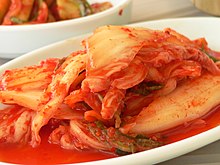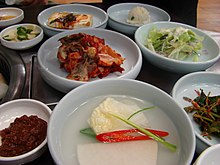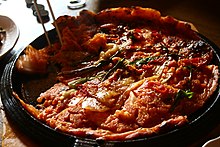Kimchi
From Wikipedia, the free encyclopedia
| Kimchi | |
|---|---|
 | |
| Korean name | |
| Hangul | 김치 |
| Revised Romanization | gimchi |
| McCune–Reischauer | kimch'i |
Contents[hide] |
[edit] History
The oldest references to kimchi can be found from 2600 to 3000 years ago.[5] The first text-written evidence of its existence can be found in the first Chinese poetry book, Shi Jing (詩經). In this book, kimchi was referred to as jeo (菹). The term ji was used until the pre-modern terms chimchae (hanja: 沈菜, lit. soaked vegetables), dimchae, and timchae were adopted in the period of the Three Kingdoms of Korea.[6] The word then was modified into jimchi, and is currently kimchi. Early kimchi was made of cabbage and beef stock only. Red chili, a New World vegetable not found in Korea before European contact with the Americas, was added to kimchi recipes some time after 1500. Red chili pepper flakes are now used as the main ingredient for spice and source of heat for many varieties of kimchi. In the twelfth century other spices, creating flavors such as sweet and sour, and colors, such as white and orange, were added.[7][edit] Main ingredients
Kimchi varieties are determined by the main vegetable ingredients and the mix of seasonings used to flavor the kimchi. The most popular type of kimchi is the baechu (napa cabbage) variety but there are many regional and seasonal varieties. Popular variants include ggakdugi which is a kimchi made with cubed radish; pa-kimchi (made with scallions); chonggak-kimchi and oisobagi (hangul: 오이소박이), a cucumber kimchi with hot and spicy seasoning; gat-kimchi (hangul: 갓김치); boochoo-kimchi (hangul: 부추김치); youlmoo-kimchi (hangul: 열무김치), a kimchi made with young radish; and Kkaennip (hangul: 깻잎) kimchi, which has layers of perilla and other spices.The Kimchi Field Museum in Seoul has documented 187 historic and current varieties of kimchi. Although the most common seasonings include brine, scallions and spices, ingredients can be replaced or added depending on the type of kimchi being made. Common seasonings also include ginger, chopped radish, garlic, saeujeot (hangul: 새우젓), and aekjeot (hangul: 액젓, fish sauce).
[edit] Kimchi varieties
Kimchi can be categorized by main ingredients, regions or seasons. Korea's northern and southern sections have a considerable temperature difference.[8]Kimchi from the northern parts of Korea tend to have less salt as well as less red chilli and usually do not have brined seafood for seasoning. Northern kimchi often has a watery consistency. Kimchi made in the southern parts of Korea, such as Jeolla-do and Gyeongsang-do, uses salt, chili peppers and myeolchijeot (hangul: 멸치젓, brined anchovy allowed to ferment) or saeujeot (hangul: 새우젓, brined shrimp allowed to ferment), myeolchiaekjeot (Hangul: 멸치액젓, "kkanariaekjeot" 까나리액젓, liquid anchovy jeot, similar to fish sauce used in Southeast Asia, but thicker). In the Seoul area saeujeot is preferred.
Saeujeot (hangul: 새우젓) or myeolchijeot is not added to the kimchi spice-seasoning mixture, but is simmered to reduce odors, eliminate tannic flavor and fats, and then is mixed with a thickener made of rice or wheat starch (Hangul: 풀). This technique has been falling into disuse for the past forty years.
Other brined jeot can be used, but are no longer common as modern commercialization has made aekjeot (액젓; either myeolchijeot or saeujeot) more affordable and convenient.
White kimchi (baek kimchi) is baechu (napa cabbage) seasoned without chili pepper and is neither red in color nor spicy. White radish kimchi (dongchimi) is another example of a popular kimchi that is not spicy. The watery white kimchi varieties are a popular ingredient in a number of dishes such as cold noodles in dongchimi brine (dongchimi guksu) and are eaten widely during the summer months.
[edit] By region
This regional classification dates back to 1960s and contains plenty of historical facts, but the current kimchi-making trends in Korea are generally different from those mentioned below.[8]- Hamgyeong-do (Upper Northeast)
- Hwanghae-do (Midwest)
- Gyeonggi-do (Lower Midwest of Hwanghae-do) Gyeonggi-do kimchi is known for its eye-catching decorations.
- Chungcheong-do (Between Gyeonggi-do and Jeolla-do)
In Gangwon-do, kimchi is stored for longer periods of time. Unlike other coastal regions in Korea, kimchi in this area does not contain much salted fish.
- Jeolla-do (Lower Southwest)
- Gyeongsang-do (Lower Southeast)
- Foreign Countries
[edit] By season
Different types of kimchi were traditionally made at different times of year, based on when various vegetable were in season and also to take advantage of hot and cold seasons before the era of refrigeration. Although the advent of modern refrigeration —- including kimchi refrigerators specifically designed with precise controls to keep different varieties of kimchi at optimal temperatures at various stages of fermentation —- has made this seasonality unnecessary, Koreans continue to consume kimchi according to traditional seasonal preferences.[11]
Dongchimi (동치미) is largely served during winter.
- Spring
- Summer
- Autumn
- Winter
[edit] Nutrition and health
Kimchi is made of various vegetables and contains a high concentration of dietary fiber, while being low in calories. One serving also provides up to 80% of the daily recommended amount of vitamin C and carotene.[citation needed] Most types of kimchi contain onions, garlic, and peppers, all of which are salutary. The vegetables being made into kimchi also contribute to the overall nutritional value. Kimchi is rich in vitamin A, thiamine (B1), riboflavin (B2), calcium, and iron,[12][13] and contains a number of lactic acid bacteria, among those the typical species Lactobacillus kimchii.[14][15][16] The magazine Health named kimchi in its list of top five "World's Healthiest Foods" for being rich in vitamins, aiding digestion, and even possibly reducing cancer growth.[17]
Kimchi jjigae. A popular stew made with kimchi, it is commonly cooked with kimchi, fresh vegetables and pork or tuna although countless variants exist.
| Nutrients | per 100 g * | Nutrients | per 100 g |
|---|---|---|---|
| Food energy | 32 kcal | Moisture | 88.4 g |
| Crude protein | 2.0 g | Crude Lipid | 0.6 g |
| Total sugar | 1.3 g | Crude fiber | 1.2 g |
| Crude ash | 0.5 g | Calcium | 45 mg |
| Phosphorus | 28 mg | Vitamin A | 492 IU |
| Vitamin B1 | 0.03 mg | Vitamin B2 | 0.06 mg |
| Niacin | 2.1 mg | Vitamin C | 21 mg |










댓글 없음:
댓글 쓰기